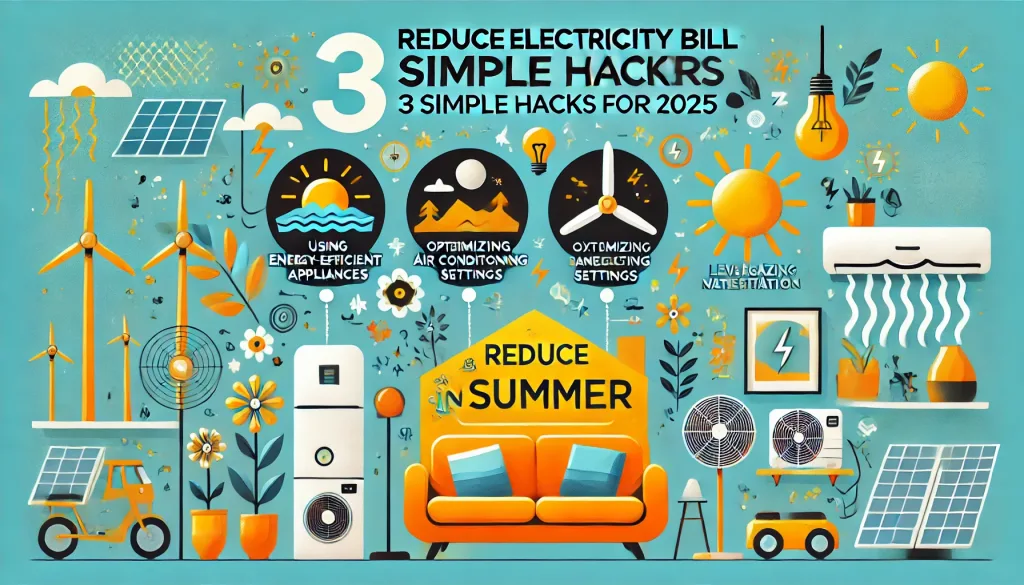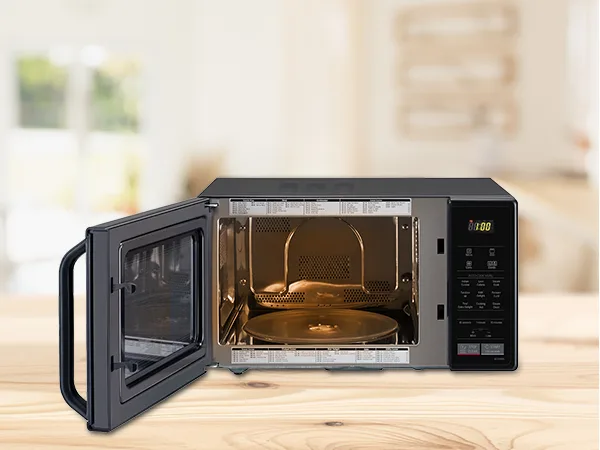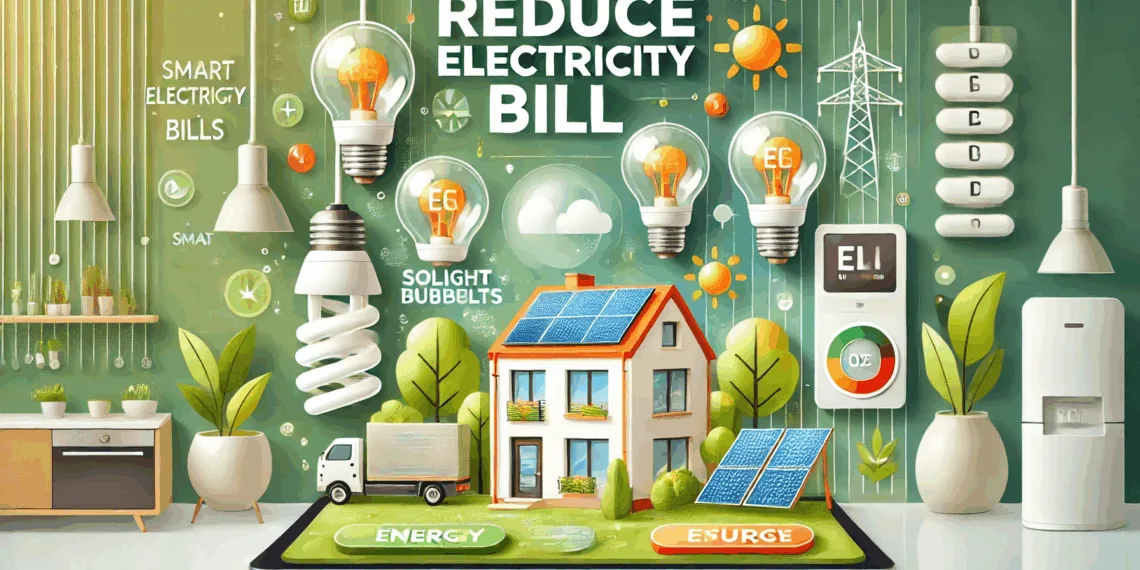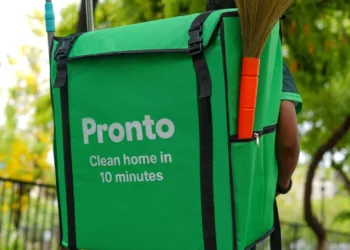Reduce Electricity Bill in Summer in 2025: As the mercury rises and air conditioners hum to life across the nation, many households brace for the inevitable surge in electricity bills. But what if you could slash those costs dramatically without sacrificing comfort? In this comprehensive guide, we’ll explore three surprisingly simple yet effective strategies to reduce your electricity consumption and keep your wallet happy this summer.
Table of Contents
Revolutionize Your Energy Savings, Reduce Electricity Bill in Summer: A Summer Guide in 2025
Summer heat can send your electricity bills soaring, but with smart strategies and simple lifestyle adjustments, you can significantly reduce energy consumption without compromising comfort. Here’s your comprehensive guide to cutting costs this season.
🌟 Top Tips to Slash Your Electricity Bill
1. Use Fans Wisely
Ceiling fans consume far less energy than air conditioners—up to 98% less! Use them as your first line of defense against heat. The wind-chill effect from fans can make a room feel 4-5°C cooler without heavy power consumption.
2. Set Your Thermostat Efficiently
Keep your AC temperature between 24–26°C for the perfect balance of comfort and savings. Every degree lower can increase energy consumption by 6-8%. Use the ‘auto’ mode instead of ‘on’ to let the compressor rest between cycles.
3. Unplug Idle Devices
Electronics on standby mode—TVs, chargers, gaming consoles—quietly drain power even when not in use. This “phantom load” can account for 5-10% of your monthly bill. Unplug devices or use power strips for easy on/off control.
4. Switch to LED Lights
Replace traditional incandescent bulbs with energy-efficient LEDs that use 75% less energy and last 25 times longer. LED lights also generate less heat, reducing your cooling requirements during summer.
5. Block Direct Sunlight
Use thick curtains, blinds, or reflective window films to block harsh sunlight during peak hours (11 AM – 4 PM). This simple step can reduce indoor temperatures by 3-5°C and significantly lighten your AC’s workload.
6. Wash Clothes in Cold Water
Heating water accounts for about 90% of the energy used by washing machines. Cold water washing saves electricity, protects fabric colors, and extends clothing lifespan—a win-win-win solution.
7. Regular AC Maintenance
Clean or replace AC filters every 2-3 weeks during heavy usage. Dirty filters force the system to work harder, consuming up to 15% more energy. Schedule professional servicing annually for optimal performance.
💡 Bonus Energy-Saving Strategies
Embrace Solar Power
Invest in solar-powered gadgets like outdoor lights, phone chargers, and water heaters. While initial costs may be higher, long-term savings are substantial.
Time Your Appliance Usage
Schedule heavy appliance use—ironing, dishwashing, laundry—during cooler morning or evening hours. This reduces heat buildup and prevents your AC from working overtime.
Use Smart Plugs
Install smart plugs to monitor real-time energy consumption. These devices provide insights into which appliances consume the most power and allow remote control via smartphone apps.
Optimize Refrigerator Settings
Set your fridge temperature between 3-4°C and freezer at -18°C. Avoid overcrowding, ensure door seals are tight, and keep the appliance away from heat sources.
Natural Ventilation
Open windows during cooler morning and evening hours to create cross-ventilation. This reduces dependency on fans and AC while maintaining fresh air circulation.
Energy-Efficient Appliances
When replacing old appliances, choose models with high BEE (Bureau of Energy Efficiency) star ratings—5-star rated appliances consume significantly less power than lower-rated alternatives.
📊 Quick Reference: Energy Consumption Comparison
| Appliance | Average Consumption | Cost-Saving Alternative |
|---|---|---|
| 1.5 Ton AC (8 hours/day) | 1200-1500W/hr | Ceiling fan: 75W/hr (95% saving) |
| 100W Incandescent Bulb | 100W/hr | 15W LED: 15W/hr (85% saving) |
| Electric Geyser | 2000W/hr | Solar heater: Nearly free after setup |
| Old 3-Star Refrigerator | 300W/hr | 5-Star model: 150W/hr (50% saving) |
🎯 The Bottom Line
Reducing your summer electricity bill doesn’t require drastic lifestyle changes—just smarter energy habits. By implementing these proven strategies, you can cut your electricity costs by 20-40% while contributing to environmental sustainability. Start with the easiest tips and gradually adopt more practices for maximum savings.
Remember: Small changes multiplied across millions of households create massive energy savings nationwide. Your conscious choices today build a more sustainable tomorrow.
💬 What energy-saving tips work best for you? Share your experiences in the comments below and help others save on their electricity bills!
The Hidden Energy Vampires in Your Home
Before we dive into our top three energy-saving hacks, let’s take a moment to understand the concept of “energy vampires.” These are devices that continue to draw power even when they’re not in active use. Identifying and addressing these silent power drains is the first step towards significant energy savings.

Hack #1: Embrace the Inverter AC Revolution
One of the most impactful changes you can make is upgrading to an inverter air conditioner. Unlike traditional AC units, inverter technology adjusts the compressor speed based on cooling needs, resulting in substantial energy savings.
Key Benefits of Inverter ACs:
- Up to 50% reduction in energy consumption
- Consistent temperature maintenance
- Longer lifespan due to reduced wear and tear
“Switching to an inverter AC was a game-changer for us. Our electricity bill dropped by 40% in the first month alone!” – Sarah Thompson, Energy-Conscious Homeowner
Table: Inverter AC vs. Conventional AC Energy Consumption
| AC Type | Energy Consumption (kWh/month) | Estimated Monthly Cost |
|---|---|---|
| Inverter | 300-400 | $45-$60 |
| Conventional | 500-600 | $75-$90 |
Note: Actual consumption and costs may vary based on usage patterns and local electricity rates.
Hack #2: The Ceiling Fan Strategy
While it might seem counterintuitive, strategic use of ceiling fans can significantly reduce your reliance on air conditioning, leading to lower energy bills.
Smart Ceiling Fan Usage Tips:
- Run fans counterclockwise in summer for a cooling effect
- Turn off fans in unoccupied rooms
- Use fans in conjunction with AC to distribute cool air more efficiently
“By using ceiling fans strategically, we were able to raise our thermostat by 4 degrees without any loss in comfort. The savings were noticeable!” – Mike Chen, Energy Efficiency Consultant

Hack #3: Microwave Mindfulness
Your microwave might be a silent contributor to your high electricity bills. Many households unknowingly leave their microwaves plugged in 24/7, resulting in standby power consumption.
Microwave Energy-Saving Tips:
- Unplug when not in use or use a power strip for easy disconnection
- Opt for microwave cooking over conventional ovens when possible
- Clean your microwave regularly for optimal efficiency
The Standby Power Drain: A Hidden Culprit
Standby power, also known as vampire power, can account for up to 10% of your home’s energy consumption. By addressing this issue with your microwave and other appliances, you can see a noticeable reduction in your electricity bill.
Beyond the Big Three: Additional Energy-Saving Strategies
While our top three hacks can lead to significant savings, there are numerous other ways to reduce your electricity consumption this summer:
- Seal air leaks: Use weatherstripping and caulk to prevent cool air from escaping.
- Optimize your thermostat: set it to 26°C when you’re home and higher when you’re away.
- Leverage natural cooling: Open windows at night to let in cool air and close them during the day.
- Maintain your AC: Regular cleaning and servicing can improve efficiency by up to 15%.
- Embrace LED lighting: Switch to energy-efficient LED bulbs for cooler, more efficient lighting.
FAQs: Your Summer Energy-Saving Questions Answered
Q: How much can I really save by implementing these tips?
A: While results vary, many households report savings of 30-50% on their summer electricity bills by implementing these strategies.
Q: Is it worth investing in an inverter AC if I have a relatively new conventional unit?
A: If your current AC is less than 5 years old and in good condition, the immediate savings might not justify the cost. However, consider upgrading when it’s time to replace your unit.
Q: Can ceiling fans really make a difference in energy consumption?
A: Absolutely! Using ceiling fans can allow you to raise your thermostat by up to 4°F without affecting comfort, resulting in significant energy savings.
Q: How do I know if my appliances are energy-efficient?
A: Look for the ENERGY STAR label, which indicates that the appliance meets strict energy efficiency guidelines set by the U.S. Environmental Protection Agency and the Department of Energy.
Conclusion: A Cooler Summer, A Happier Wallet
By implementing these three simple yet effective hacks—upgrading to an inverter AC, using ceiling fans strategically, and being mindful of microwave usage—you can significantly reduce your electricity bill this summer. Remember, the key to sustainable energy savings is a combination of smart technology choices and mindful habits.
As we move towards a more energy-conscious future, these small changes can add up to big savings, both for your wallet and the environment. Stay cool, save money, and enjoy a more sustainable summer!







